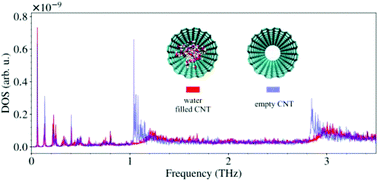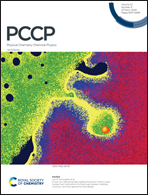Phonon coupling induced thermophoresis of water confined in a carbon nanotube†
Abstract
The controlled transport of water through nanoscale devices is an important requirement in the design and development of various nanofluidic systems. Molecular dynamics simulations are performed to investigate the phonon coupling induced thermophoretic transport of water through a carbon nanotube (CNT). Phonon coupling is believed to have a significant role in the transport of heat at the liquid–solid interface. The thermally induced vibrational modes of water-filled and empty CNTs are examined at various thermal gradients. The spatial asymmetry along the length of a CNT due to the imposed thermal gradient contributes to the diffusion enhancement of water confined in the CNT, but does not have a strong correlation with the applied thermal gradient. Analysis shows that the vibrational modes present in the center-of-mass oscillations of CNTs do not play any significant role in the development of the thermophoretic force on water. The low-frequency phonon vibrational modes of CNTs are suppressed due to the phonon coupling between water and the CNT. Also, we observed that the spectral heat current across the water–CNT interface dominates at frequencies below 5 THz, which is the same frequency range as radial breathing modes observed in the vibrational spectrum of CNT. This observation leads us to the conclusion that the coupling of radial breathing phonon modes contributes significantly to thermophoresis. This study substantiates the existence of phonon coupling at the water–CNT interface and quantifies the accumulated heat transfer across the interface.



 Please wait while we load your content...
Please wait while we load your content...